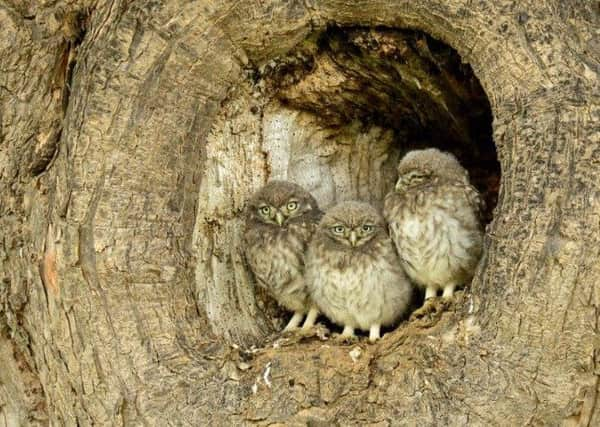Birdwatch: Beady eyed farmland hunters gather strength


The parents tempt them out of the holes in trees or farm buildings where they were hatched with titbits such as earthworms.
Then the youngsters, paler fluffier versions of the parents, roost nearby, still in their natal territories where they remain until September developing their hunting and survival skills.
Advertisement
Hide AdAdvertisement
Hide AdTheir parents keep a watch on them until then, chasing off would-be predators, but after September the young ones are on their own.
Most of those that survive until next year will pair up and rear their own broods.
Little owls are the original wise owl associated with the Greek goddess Pallas Athene.
They’re here because of a series of introductions by naturalists in the 19th and early 20th centuries. The first attempt, by Charles Waterton at Walton Hall near Wakefield using birds from Italy, was a failure but Baron Lilford’s releases on his Northamptonshire estate proved more successful.
Advertisement
Hide AdAdvertisement
Hide AdNow they are a familiar sight in our countryside as far north as the Borders and their dappled plumage, glaring bright yellow eyes, and frowning expression make them a favourite with photographers.
But numbers have declined across Europe with farming methods blamed for the removal of nest sites in hedgerows and orchards. Also there are fewer invertebrates which make up about half their diet. They also hunt voles and small birds.
Busy roads take their toll too and, with little owls on the northernmost edge of their range in this country, they’re vulnerable to starvation in prolonged periods of cold weather.
Numbers are now being regularly monitored. This year the UK Little Owl Project run by Dr Emily Jouchim of Reading University is appealing for information on breeding records. Contact her on the project’s website.
Advertisement
Hide AdAdvertisement
Hide AdTwo young Montagu’s harriers, thought to be a male and a female, have been flying with the adult pair over Blacktoft Sands reserve near Goole this week, delighting staff and volunteers and a reward for the many hours they have put in guarding the nest
There have only been seven nesting female Montagu’s harriers and four males in England this year and this is the second year running that a pair has bred in the Blacktoft area.
Waders have included a Temminck’s and little stint and two wood sandpipers at Spurn while a white-rumped sandpiper and three curlew sandpipers were at Beacon Ponds. Short and long-eared owls were also seen at Spurn and a short-eared at the Bempton Cliffs reserve.
A singing golden oriole was present around the Skylark and Partridge fishing lakes at Carlton Miniott, Thirsk.
The little bittern remained on the Old Moor reserve, South Yorkshire while a white stork was seen at Kirby Misperton and two cranes at Potter Brompton.